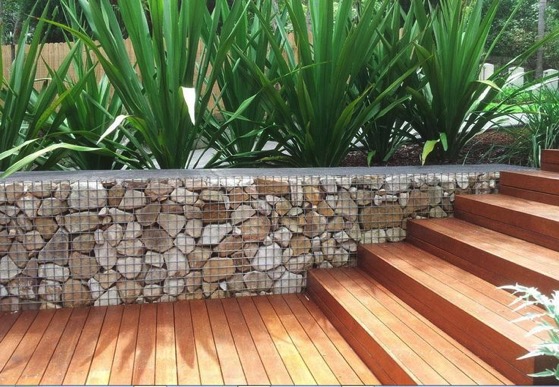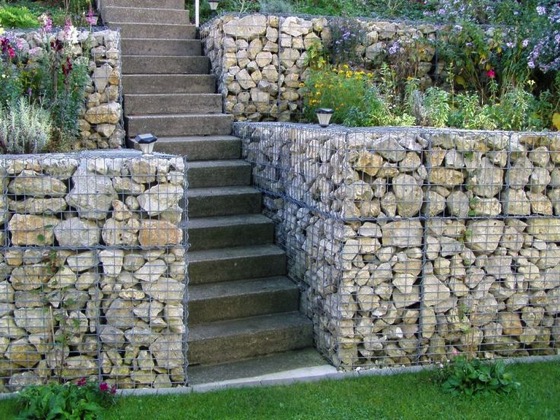Gabion Walls
Gabion walls are an interesting style that can be adapted in many different ways. They are basically wire baskets filled with whatever stone you wish. They can be basic and functional or quite decorative, as well as large, small and everything in-between.
Discovered via Pinterest User Linda Hedderig
More information on gabion walls from Wikipedia…
A gabion (from Italian gabbione meaning “big cage”; from Italian gabbia and Latin cavea meaning “cage”) is a cage, cylinder, or box filled with rocks, concrete, or sometimes sand and soil for use in civil engineering, road building, military applications and landscaping.
For erosion control, caged riprap is used. For dams or in foundation construction, cylindrical metal structures are used. In a military context, earth- or sand-filled gabions are used to protect artillery crews from enemy fire.
Leonardo da Vinci designed a type of gabion called a Corbeille Leonard (“Leonard[o] basket”) for the foundations of the San Marco Castle in Milan.[1]
The most common civil engineering use of gabions was refined and patented by Gaetano Maccaferri in the late 1800s in Sacerno, Emilia Romagna and used to stabilize shorelines, stream banks or slopes against erosion. Other uses include retaining walls, temporary flood walls, silt filtration from runoff, for small or temporary/permanent dams, river training, or channel lining.[2] They may be used to direct the force of a flow of flood water around a vulnerable structure.
Gabions are also used as fish screens on small streams. Gabion stepped weirs are commonly used for river training and flood control; the stepped design enhances the rate of energy dissipation in the channel, and it is particularly well-suited to the construction of gabion stepped weirs.[3]
A gabion wall is a retaining wall made of stacked stone-filled gabions tied together with wire. Gabion walls are usually battered (angled back towards the slope), or stepped back with the slope, rather than stacked vertically.
Gabion baskets have some advantages over loose riprap because of their modularity and ability to be stacked in various shapes; they are also resistant to being washed away by moving water. Gabions also have advantages over more rigid structures, because they can conform to subsidence, dissipate energy from flowing water, and drain freely. Their strength and effectiveness may increase with time in some cases, as silt and vegetation fill the interstitial voids and reinforce the structure. — Wikipedia
More information on gabion walls:
Books on Gabion Walls from Amazon.com:
* A portion of each sale from Amazon.com directly supports our blogs
** Many of these books may be available from your local library. Check it out!
Previously in Garden Decor:
- Garden-themed mugs
- Corrugated Steel Garden Beds (or re-purposed cattle troughs)
- Cast Concrete Planters
- Making a mini wildlife stack from The Guardian
- Chalkboard Pots for the Garden
- Bring the garden indoors with these lovely garden throw pillows
- Niteangel Natural Insect Hotel Bee Bug House/Hotel
- Plant Nanny 6051 4 Count Wine Bottle Stake Set
- Torre And Tagus French Bulldog Watering Can
- Sagaform White/Cream Ceramic Birdy Bird Feeder
- Round Copper Planters
- Stump and Plank Garden Bench
- Garden Window and other great ideas from House and Garden UK
- Oxidized Steel Fire Basket by Menu
- Copper Pipe Tiki Torches DIY
- Topiary Doorway
- See all past Garden Decor entries







